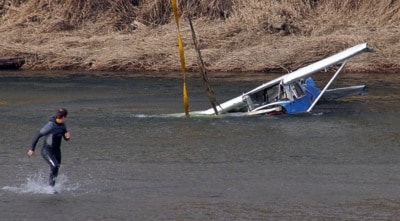The Transportation Safety Board released its investigation report into the Feb. 9, 2011 midair collision between two Cessna 150 aircraft that killed two, including 60-year-old Langley pilot Donn Hubble.
Not enough preflight preparation along with the need for extensive training required with formation flying are the causes of the midair crash, the TSB report concludes.
The two Cessnas were part of a four aircraft flying in a diamond formation over Mission when one of the planes rear-ended the lead Cessna.
During a right turn while in formation, the aircraft on the right lost sight of the leader, said the TSB in its report. While trying to regain sight of the leader, the aircraft climbed, turned left, and rear-ended the lead plane.
The two aircraft briefly joined together and descended out of control until about 400 feet above the ground where they managed to separate.
The lead plane then broke up and continued descending out of control to the ground, crashing into Mission's Nicomen Slough. Both of its occupants died in the crash, including passenger Patrick Lobsinger, 70, of Surrey. The other aircraft's pilot regained control of his plane and landed in a nearby field without engine power. He was uninjured.
“"Formation flying is a challenging activity requiring high levels of skill and discipline," said Bill Yearwood, manager of air investigation operations for the TSB.
"Without appropriate training and thorough preflight briefings, there is an increased risk of in-flight collisions, and these collisions often cause fatal accidents."
Training is required for formation flying during events such as air shows.
However, for casual formation flight outside of air shows, the only regulatory requirement is a pre-arrangement between pilots intending to fly in formation. The group had a pre-flight briefing to discuss join-up procedures after takeoff and breakout procedures, said the TSB report.
However, this briefing did not discuss the procedures for loss of sight of an aircraft, nor did it review the practices for returning to the formation. Further, the investigation found that flying in formation in high-wing aircraft such as the Cessna 150 poses an elevated risk of loss of visual contact, due to the limited cockpit vision angles.
Since the accident, Transport Canada issued a safety bulletin regarding the hazards associated with formation flying. It highlights the importance of pre-flight planning and flying skills in reducing the associated risks.
The two planes were part of a foursome that regularly practised formation flying, and took off from Langley Airport.
In 2011, Langley airport manager George Miller said the small team had taken part in Remembrance Day fly-overs in the area for the past six years.
